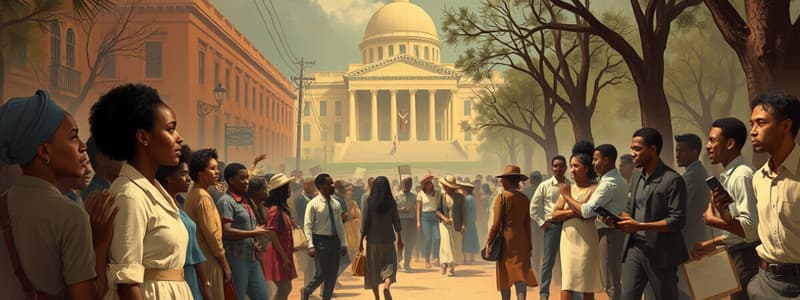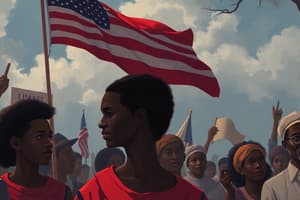Podcast
Questions and Answers
What was a significant outcome of the Civil Rights Movement of the 1960s?
What was a significant outcome of the Civil Rights Movement of the 1960s?
- The introduction of Jim Crow laws
- Major laws were enacted to protect against discrimination (correct)
- The rise of anti-civil rights organizations
- Increased segregation in public places
What method did civil rights activists primarily use to protest against segregation?
What method did civil rights activists primarily use to protest against segregation?
- Legal battles and lawsuits
- Non-violent protests and marches (correct)
- Armed conflict and violence
- Economic boycotts of businesses
What role did televised incidents of violence play in the Civil Rights Movement?
What role did televised incidents of violence play in the Civil Rights Movement?
- They shifted focus away from voting rights
- They were used as tools to further segregate society
- They discouraged public support for civil rights
- They increased awareness and support for civil rights legislation (correct)
Which of the following groups was primarily antagonistic toward the Civil Rights Movement?
Which of the following groups was primarily antagonistic toward the Civil Rights Movement?
What was a primary focus of the Civil Rights Movement concerning voting?
What was a primary focus of the Civil Rights Movement concerning voting?
Flashcards are hidden until you start studying
Study Notes
Overview of the Civil Rights Movement
- The movement occurred during the 1960s, focusing on ending segregation and combating Jim Crow laws in the United States.
- Key figures and organizations played significant roles in orchestrating protests and political actions to demand civil rights.
Major Achievements and Legislation
- Legislation passed during this period provided critical protections against discrimination in:
- Housing
- Employment
- Voting rights
- These legal advancements contributed to the dismantling of systemic inequality, previously upheld by the doctrine of "separate but equal."
Impact of Non-Violent Protests
- Activists engaged in non-violent protests, but faced severe violence from opponents, particularly in Southern states.
- Incidents of brutality against peaceful demonstrators were widely broadcasted, impacting public opinion and increasing support for civil rights reforms.
Reaction to Violence and Public Perception
- The violent actions of groups like the Ku Klux Klan highlighted the urgent need for change and prompted governmental action to address racial inequities.
- Legislation enacted in response aimed to foster a more equitable society, emphasizing the importance of civil rights for all Americans.
Studying That Suits You
Use AI to generate personalized quizzes and flashcards to suit your learning preferences.




